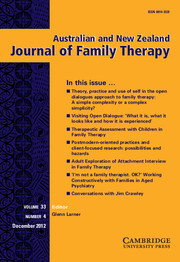Article contents
Creating Dialogic Contexts for Multidisciplinary Clinical Reviews: The Reflecting Team Process
Published online by Cambridge University Press: 02 March 2012
Abstract
When multidisciplinary teams review their work, it is common for clinicians to hypothesise about their clients from the perspective of their role or theoretical model. The outcome of this review process may depend on the team's views. Here the epistemological position taken by team members about reality and objectivity can lead to starkly different pathways. There can either be a dialogue about different hypotheses, with the team jointly constructing new meanings; or, conversely, there can be a monologic exchange based on competition between different hypotheses. This paper explores why teams may struggle with coordinating different theoretical approaches and models. It suggests the dialogic nature of a reflecting team process offers one approach for helping teams to find ways of ‘putting their differences to work’. Ideas for implementing this process within multidisciplinary teams are illustrated with comments provided by teams who have begun to experiment with this approach.
- Type
- Articles
- Information
- Australian and New Zealand Journal of Family Therapy , Volume 32 , Issue 4 , December 2011 , pp. 283 - 299
- Copyright
- Copyright © Cambridge University Press 2011
References
- 5
- Cited by


